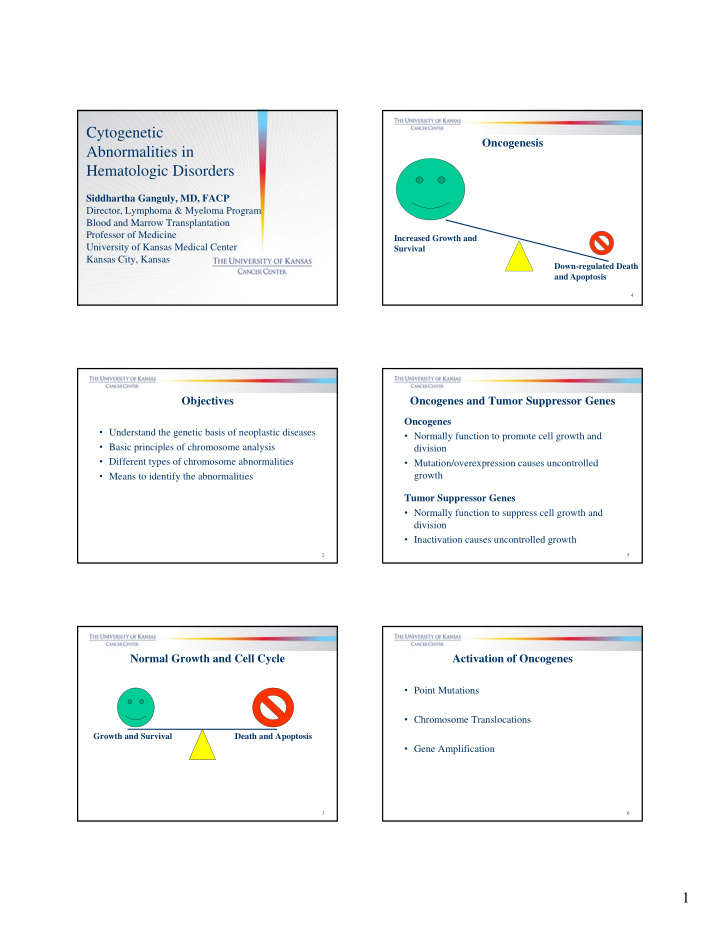



Cytogenetic Oncogenesis Abnormalities in Hematologic Disorders Siddhartha Ganguly, MD, FACP Director, Lymphoma & Myeloma Program Blood and Marrow Transplantation Professor of Medicine Increased Growth and University of Kansas Medical Center Survival Kansas City, Kansas Down-regulated Death and Apoptosis 4 Objectives Oncogenes and Tumor Suppressor Genes Oncogenes • Understand the genetic basis of neoplastic diseases • Normally function to promote cell growth and • Basic principles of chromosome analysis division • Different types of chromosome abnormalities • Mutation/overexpression causes uncontrolled growth • Means to identify the abnormalities Tumor Suppressor Genes • Normally function to suppress cell growth and division • Inactivation causes uncontrolled growth 2 5 Normal Growth and Cell Cycle Activation of Oncogenes • Point Mutations • Chromosome Translocations Growth and Survival Death and Apoptosis • Gene Amplification 3 6 1
Methods to Identify Genetic basis of Philadelphia Chromosome of CML Diseases • Chromosome analysis (Karyotyping) • FISH • PCR • mRNA and micro RNA • Proteomics The abnormality seen by Nowell & Hungerford on chromosome 22. Now know as the Philadelphia Chromosome. 7 10 Human Chromosomes region p1 p arm centromere region q1 q arm region q2 8 11 Normal metaphase vs. Normal male karyogram Nomenclature Normal metaphase Normal male karyogram 22q11.2 46, XY 9 12 2
Chromosome Disorders Trisomy 21 • Conditions associated with visible changes in chromosomes – Limited to fairly large gains, losses or rearrangements of chromosomal material 13 16 Clinical Cytogenetics Consequences of Chromosome Abnormalities in Cancer • Acquired Abnormalities • Translocations – Leukemia and lymphoma – Fusion proteins – Overexpression of normal proteins • Constitutional Abnormalities • Deletions – Prenatal diagnosis – Loss of tumor suppressor genes – Newborns/children with multiple congenital abnormalities • Amplifications of genes – Adults with infertility – Oncogene overexpression 14 17 Types of chromosome abnormalities Mechanisms by which chromosome translocations active oncogenes • Numeric abnormalities – Diploid, haploid, aneuploid, tetraploid, monosomy, trisomy • Structural abnormalities – Translocations, deletions, duplications, inversions, rings Fusion protein- bcr/abl in chronic myelogenous leukemia increased tyrosine kinase activity 15 18 3
Inversion 16 (p13:q22) Normal Cell & ABL/BCR fusion Normal Cell ABL/BCR fusion 19 22 Florescence in Situ Hybridization Let us Read a Report! • 70 year old male admitted with acute leukemia add 16 (p2.1); del 3q13; t(8:14)(q24:q32); der 16p32/44-46 XY; FISH was positive for t(8:14)(c-myc:IgH)(q24:q32) • Flow cytometry was suggestive of pre-B ALL • Treated with Hyper CVAD • After 2 cycles: 46, XY • After 4th cycle relapsed with: add 16 (p2.1); del 3q13; -7; t(8:14)(q24:q32); der 16p32/44-46 XY • Clonal evolution and planning for cord blood transplantation 20 23 Probe M bcr/abl In Cells With A t(9;22)(q34;q11.2) What we learned! • Understood the genetic basis of neoplastic diseases • Basic principles of chromosome analysis • Different types of chromosome abnormalities • Means to identify the abnormalities by Karyotyping and FISH • How to read a report 21 24 4
Recommend
More recommend